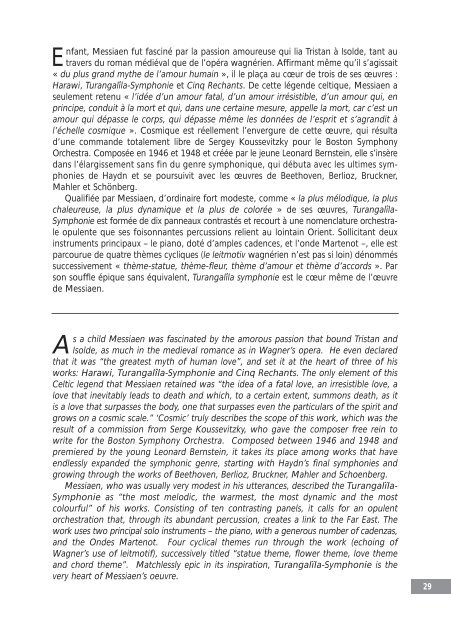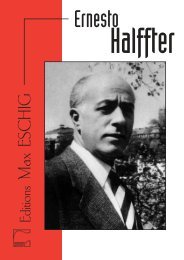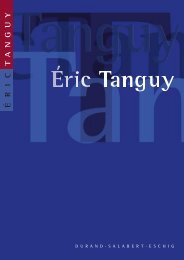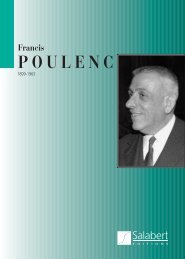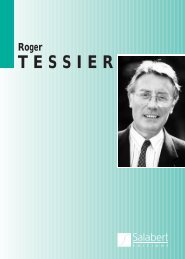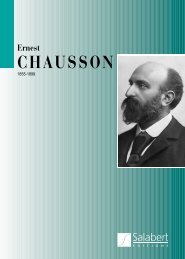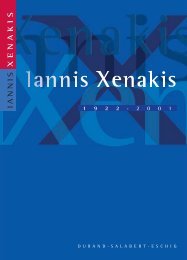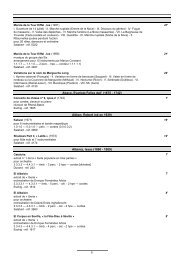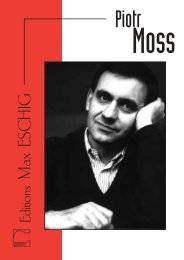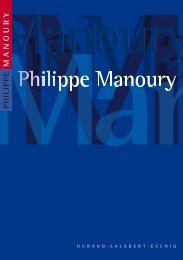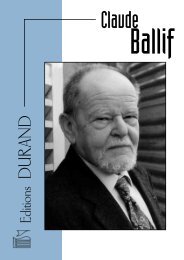messiaen olivier 1 9 0 8 - Durand Salabert Eschig
messiaen olivier 1 9 0 8 - Durand Salabert Eschig
messiaen olivier 1 9 0 8 - Durand Salabert Eschig
Create successful ePaper yourself
Turn your PDF publications into a flip-book with our unique Google optimized e-Paper software.
E nfant, Messiaen fut fasciné par la passion amoureuse qui lia Tristan à Isolde, tant au<br />
travers du roman médiéval que de l’opéra wagnérien. Affirmant même qu’il s’agissait<br />
« du plus grand mythe de l’amour humain », il le plaça au cœur de trois de ses œuvres :<br />
Harawi, Turangalîla-Symphonie et Cinq Rechants. De cette légende celtique, Messiaen a<br />
seulement retenu « l’idée d’un amour fatal, d’un amour irrésistible, d’un amour qui, en<br />
principe, conduit à la mort et qui, dans une certaine mesure, appelle la mort, car c’est un<br />
amour qui dépasse le corps, qui dépasse même les données de l’esprit et s’agrandit à<br />
l’échelle cosmique ». Cosmique est réellement l’envergure de cette œuvre, qui résulta<br />
d’une commande totalement libre de Sergey Koussevitzky pour le Boston Symphony<br />
Orchestra. Composée en 1946 et 1948 et créée par le jeune Leonard Bernstein, elle s’insère<br />
dans l’élargissement sans fin du genre symphonique, qui débuta avec les ultimes symphonies<br />
de Haydn et se poursuivit avec les œuvres de Beethoven, Berlioz, Bruckner,<br />
Mahler et Schönberg.<br />
Qualifiée par Messiaen, d’ordinaire fort modeste, comme « la plus mélodique, la plus<br />
chaleureuse, la plus dynamique et la plus de colorée » de ses œuvres, Turangalîla-<br />
Symphonie est formée de dix panneaux contrastés et recourt à une nomenclature orchestrale<br />
opulente que ses foisonnantes percussions relient au lointain Orient. Sollicitant deux<br />
instruments principaux – le piano, doté d’amples cadences, et l’onde Martenot –, elle est<br />
parcourue de quatre thèmes cycliques (le leitmotiv wagnérien n’est pas si loin) dénommés<br />
successivement « thème-statue, thème-fleur, thème d’amour et thème d’accords ». Par<br />
son souffle épique sans équivalent, Turangalîla symphonie est le cœur même de l’œuvre<br />
de Messiaen.<br />
As a child Messiaen was fascinated by the amorous passion that bound Tristan and<br />
Isolde, as much in the medieval romance as in Wagner’s opera. He even declared<br />
that it was “the greatest myth of human love”, and set it at the heart of three of his<br />
works: Harawi, Turangalîla-Symphonie and Cinq Rechants. The only element of this<br />
Celtic legend that Messiaen retained was “the idea of a fatal love, an irresistible love, a<br />
love that inevitably leads to death and which, to a certain extent, summons death, as it<br />
is a love that surpasses the body, one that surpasses even the particulars of the spirit and<br />
grows on a cosmic scale.” ‘Cosmic’ truly describes the scope of this work, which was the<br />
result of a commission from Serge Koussevitzky, who gave the composer free rein to<br />
write for the Boston Symphony Orchestra. Composed between 1946 and 1948 and<br />
premiered by the young Leonard Bernstein, it takes its place among works that have<br />
endlessly expanded the symphonic genre, starting with Haydn’s final symphonies and<br />
growing through the works of Beethoven, Berlioz, Bruckner, Mahler and Schoenberg.<br />
Messiaen, who was usually very modest in his utterances, described the Turangalïla-<br />
Symphonie as “the most melodic, the warmest, the most dynamic and the most<br />
colourful” of his works. Consisting of ten contrasting panels, it calls for an opulent<br />
orchestration that, through its abundant percussion, creates a link to the Far East. The<br />
work uses two principal solo instruments – the piano, with a generous number of cadenzas,<br />
and the Ondes Martenot. Four cyclical themes run through the work (echoing of<br />
Wagner’s use of leitmotif), successively titled “statue theme, flower theme, love theme<br />
and chord theme”. Matchlessly epic in its inspiration, Turangalïla-Symphonie is the<br />
very heart of Messiaen’s oeuvre.<br />
29


